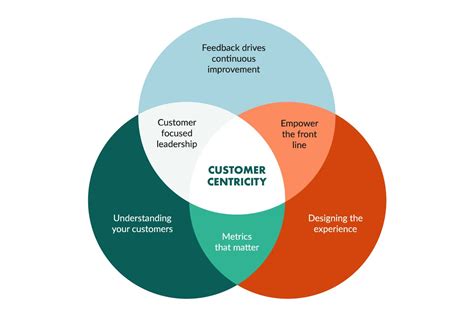In the ever-evolving business landscape, thriving organizations have recognized the paramount importance of placing the customer at the heart of their operations. This customer-centric approach, a strategic shift with tangible benefits, has emerged as a key differentiator in driving business success. In this comprehensive 3,500-word guide, we delve into the profound impact of customer-centricity, examining its multifaceted facets, exploring real-world examples, and outlining actionable strategies to empower businesses in embracing this transformative philosophy.

The Imperative of Customer-Centricity
According to a recent study by Bain & Company, companies that excel in customer-centricity achieve 60% higher profit margins than those that do not prioritize customer experience. This compelling statistic underscores the inextricable link between customer satisfaction and business prosperity.
Customer-centricity extends beyond mere lip service or hollow promises. It entails a fundamental mindset shift, where every aspect of a business, from product development to marketing and customer service, revolves around meeting the evolving needs and expectations of customers.
Unveiling the Pillars of Customer-Centricity
The cornerstone of a successful customer-centric strategy lies in embracing the following pillars:
1. Customer Understanding
A comprehensive understanding of customer demographics, psychographics, and behavior patterns is essential for tailoring products, services, and marketing efforts to meet their specific needs.
2. Customer Engagement
Building lasting relationships with customers requires active engagement, proactively reaching out and establishing meaningful connections through multiple channels.
3. Customer Experience
Every interaction with a customer, whether online or offline, shapes their overall experience with a brand. Optimizing customer experience at every touchpoint is crucial for fostering loyalty.
4. Customer Feedback
Soliciting and acting on customer feedback provides invaluable insights into customer needs, preferences, and areas for improvement.
Real-World Success Stories
Numerous businesses have reaped the rewards of adopting a customer-centric approach:
- Amazon’s relentless focus on customer convenience and personalization has catapulted it to become one of the world’s most successful e-commerce giants.
- Southwest Airlines’ unwavering commitment to customer service has consistently earned it top ratings in the airline industry.
- Zappos’ legendary customer service, with its emphasis on resolving issues quickly and efficiently, has transformed it into a customer experience icon.
Strategies for Embracing Customer-Centricity
Elevating customer-centricity requires a concerted effort across the organization:
1. Establish Customer-Centric Goals
Align company goals with customer-centric objectives, focusing on metrics such as customer satisfaction, loyalty, and lifetime value.
2. Empower Employees
Provide employees with the training, resources, and autonomy they need to resolve customer issues promptly and effectively.
3. Leverage Technology
Implement customer relationship management (CRM) systems and other technologies to manage customer data, track interactions, and personalize experiences.
4. Create a Culture of Continuous Improvement
Foster a culture where employees are encouraged to seek out customer feedback, identify areas for improvement, and implement positive changes based on customer insights.
The Customer-Centricity Innovation Generator
Our innovative “CogniCog” method empowers businesses to generate groundbreaking ideas for new customer-centric applications:
- Capture (C): Identify customer pain points, unmet needs, and areas for innovation.
- Cognize (O): Deeply understand customer behavior, motivations, and decision-making processes.
- Cogitate (G): Develop innovative solutions that address customer needs and exceed expectations.
- Communicate (N): Clearly articulate the value proposition and benefits of these solutions to customers.
- Collaborate (I): Engage with customers throughout the ideation process to ensure solutions truly meet their needs.
Tables: Metrics for Measuring Customer-Centricity
| Metric | Description |
|---|---|
| Customer Satisfaction Score (CSAT) | Measures overall customer satisfaction with products, services, or interactions. |
| Net Promoter Score (NPS) | Evaluates customer loyalty by measuring the willingness to recommend a business to others. |
| Customer Lifetime Value (CLTV) | Calculates the total revenue a customer is expected to generate over their lifetime with a business. |
| Customer Effort Score (CES) | Assesses the ease and efficiency of customer interactions with a business. |
| Channel | Customer Engagement Strategies |
|---|---|
| Personalized email campaigns, targeted content, and automated responses. | |
| Social Media | Active engagement, responsive customer support, and user-generated content campaigns. |
| Chatbots | 24/7 customer support, automated FAQs, and personalized product recommendations. |
| Phone | Efficient call routing, knowledgeable customer service representatives, and timely follow-ups. |
| Department | Customer Experience Optimization |
|---|---|
| Marketing | Targeted campaigns, personalized messaging, and a focus on delivering value. |
| Sales | Personalized sales pitches, solutions-based approach, and building long-term customer relationships. |
| Customer Service | Empathetic interactions, rapid issue resolution, and proactive customer follow-ups. |
| Product Development | Incorporating customer feedback, user testing, and designing products that meet customer needs. |
| Customer Feedback Collection Methods | |
|---|---|
| Surveys | Structured questionnaires to gather customer opinions and insights. |
| Focus Groups | In-depth discussions with a selected group of customers to explore their experiences and preferences. |
| Social Media Monitoring | Tracking customer comments, reviews, and feedback on social media platforms. |
| Customer Service Interactions | Capturing customer feedback during support interactions, identifying common issues and areas for improvement. |
Conclusion
Embracing customer-centricity is not merely a buzzword but a fundamental shift in business philosophy, with profound implications for business success. By understanding customers deeply, engaging them effectively, optimizing their experiences, and continuously striving for improvement, organizations can unlock new levels of loyalty, drive growth, and ultimately achieve the pinnacle of business success.
